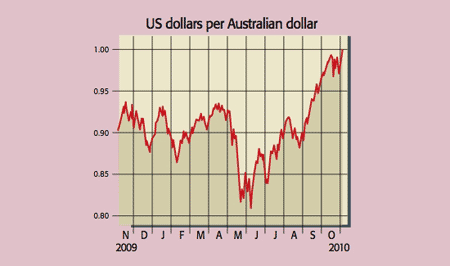The Australian dollar reached parity with its US counterpart this week. That was its strongest level since it floated in the 1980s. The trigger for the latest jump was an unexpected rise in interest rates to 4.75%. That move pre-empts a rise in inflation in the Australian economy, which grew by an annual 3.3% in the second quarter of 2010. The 'Aussie' has gained 11% against the US dollar this year.
What the commentators said
Australia appears to be "a conscientious objector" in the global currency war, said Peter Garnham in the FT. The Aussie's strength is due to comparatively high interest rates and a widening gap between Australian rates and global ones, thanks to the strong economy. That in turn is partly a commodities and China story. China is gobbling up Australia's raw materials, notably coal and iron ore. Indeed, Australia's terms of trade export compared to import prices are at a 50-year high.
Add in a recent improvement in investor sentiment, which favours commodity currencies, and you have "a potent mixture promoting a stronger currency", said Standard Chartered. But buying ('going long') the Aussie is hardly a risk-free trade. For starters, "a sharp bout of risk aversion has been the catalyst" for corrections in the past. These "are not gentle affairs". During the credit crunch the Aussie fell by 40% in three months.
MoneyWeek
Subscribe to MoneyWeek today and get your first six magazine issues absolutely FREE

Sign up to Money Morning
Don't miss the latest investment and personal finances news, market analysis, plus money-saving tips with our free twice-daily newsletter
Don't miss the latest investment and personal finances news, market analysis, plus money-saving tips with our free twice-daily newsletter

A bounce in the US dollar would also hit the Aussie, since it implies a decline in risk appetite and hampers commodities. Another potential problem is that the slowdown in advanced economies is likely to affect China, curbing demand there the decline in real exports has accelerated since June. Meanwhile, a house price bubble and sky-high household debt-to-income ratio of 164% are the key domestic worries. The long-term trend is nonetheless encouraging, and many analysts see further gains for now. Kit Juckes of Socit Gnrale expects a rate of $1.05 to the greenback. But there are plenty of factors that could bring the "Aussie party", as HSBC put it, to an end.
Get the latest financial news, insights and expert analysis from our award-winning MoneyWeek team, to help you understand what really matters when it comes to your finances.
MoneyWeek is written by a team of experienced and award-winning journalists, plus expert columnists. As well as daily digital news and features, MoneyWeek also publishes a weekly magazine, covering investing and personal finance. From share tips, pensions, gold to practical investment tips - we provide a round-up to help you make money and keep it.
-
 How gifting money this Christmas could lower your inheritance tax bill
How gifting money this Christmas could lower your inheritance tax billCash is an easy and quick present to give over Christmas – and it could protect some of your estate from the taxman down the line
-
 £100 contactless card limit to be lifted
£100 contactless card limit to be liftedConsumers will be able to set their own contactless limits from March 2026, under new rules from the Financial Conduct Authority

